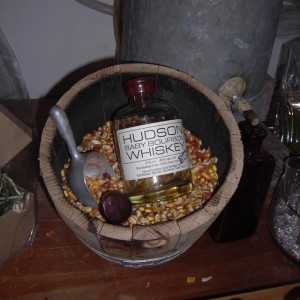A visit to Tuthilltown Spirits

I traveled up to the Hudson Valley this weekend to re-energize from the grueling pace of the City. While I was up there, I decided to head over to Tuthilltown Spirits for a distillery tour, a tasting, and nice chat with Gable Erenzo (Distiller, Brand Ambassador, etc.). As you know, I am a huge fan of the micro-distillation movement. So, this was a particular treat for me.
When Tuthilltown opened around six years ago, they were the first whiskey distillery in New York State since prohibition. They are no longer the only (Finger Lakes Distilling started producing whiskey this year), but they are still the first and there are a few other things that make them special. Every whiskey produced at Tuthilltown is double distilled. They have a “large” 400 gallon combination pot and column still that uses a steam jacket to heat the mash (which includes the solids from fermentation for a more flavorful product). There is another smaller still for the second distillation.
As with many of the microdistillers, Tuthilltown uses a variety of small barrels for maturation. Smaller barrel size allows for greater surface area contact between wood and spirit, thus speeding up the maturation process. Since the whiskey only matures 6-10 months, the spirit does not experience the environmental changes that a 3-6 year old bourbon from one of the Kentucky behemoths feel. In an attempt to rectify this situation, the warehouse walls are lined with baseboard heaters. The heaters are powered with hot waste-water from the stills. So, when the stills are running, the warehouse gets very warm, but the warehouse can get very cold (in the winter at least) when the stills are dormant for the night. Additionally, there are bass speakers placed all over the warehouse that play very deep bass each night. Gable calls this “sonic aging”. The bass vibrates the barrels, agitating the spirit and creating micro expansions and contractions in the barrels themselves. If you visit Tuthilltown, you will notice another oddity. They store their barrels on end. When I asked Gable if he noticed a difference in the end product. He said they’ve always done it that way, so he’s never been able to compare They regularly rotate the barrels though.
What is really striking about Tuthilltown is their commitment to the environment. Except for the oak in the barrels and the malted barley in their single malt and four grain whiskies, all of their whiskey ingredients are grown within 10 miles of the distillery. The waste water from distillation is used to heat the warehouse and is then circulated through a reed pond to be absorbed by the reeds. They currently burn the waste alcohols for fuel and the ultimate goal is to be completely off grid.
While whiskey is job #1 at Tuthilltown, Gable and his father Ralph (along with business partner Brian Lee and a small staff of workers) also supply the Hudson Valley, New York City and select other markets with rum and vodka. The vodka is made from cider produced at a farm down the road and they offer both a double distilled (Heart Of The Hudson) and a triple distilled variety (Spirit Of The Hudson). My wife and I both prefer the Heart of the Hudson Vodka. Triple distillation is overkill and makes it just another vodka. The double distilled spirit smells strongly of fresh apples and carries a hint of the flavor.
Due to the nature of their license, the tasting room can only pour spirits made from local products. So you won’t find the single malt or the rum in the tasting room. I’m a fan of their whiskeys in general and you can read our review of the Four Grain Bourbon here. The Manhattan Rye is one of my favorite ryes (although the one they bottled for Park Avenue Liquors is even better than the standard). They offer a Baby Bourbon (100% corn bourbon aged in tiny casks for about 6 months) and un-aged corn whiskey (which is surprisingly smooth and flavorful). Richard and I will be posting a formal review of the latest bottling of New York Whiskey this week. The New York Whiskey line is Tuthilltown’s experimental collection. This bottling is 100% wheat. It’s smooth and lovely.
So what is on the horizon for Tuthilltown? Well, they have already laid down some whiskey in second use barrels for bourbon style whiskey. They won’t be able to call it “bourbon” because of the second use barrels, but I’m sure it will be well received. Whiskey enthusiasts and cocktail crafters alike love Tuthilltown whiskeys but some complain about the price point. It’s around $45 for 375ml of their main whiskey line. The second use matured whiskeys will be available under another label at a lower price point. Gable is also growing some hops on the property for a hop infused whiskey. I really enjoyed Charbay’s hop infused whiskey, I can’t wait to see Tuthilltown’s offering.
If you want more information about Tuthilltown or for a tour, check out the website.
Drink well, drink responsibly.
-Matt

